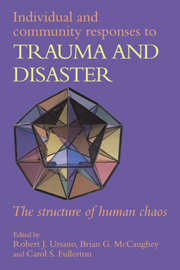Book contents
- Frontmatter
- Contents
- List of contributors
- Foreword
- Preface
- Part I Introduction
- Part II The nature of traumatic stress
- 2 The psychology of terror and its aftermath
- 3 Exposure to traumatic death: the nature of the stressor
- 4 Psychological and psychiatric aspects of technological disasters
- 5 Traumatic effects of accidents
- 6 The human experience of earthquakes
- 7 Psychological effects of toxic contamination
- Part III The role of psychosocial context in responses to trauma and disasters
- Part IV Responses to trauma across the life cycle
- Part V Conclusions
- Index
7 - Psychological effects of toxic contamination
from Part II - The nature of traumatic stress
Published online by Cambridge University Press: 13 October 2009
- Frontmatter
- Contents
- List of contributors
- Foreword
- Preface
- Part I Introduction
- Part II The nature of traumatic stress
- 2 The psychology of terror and its aftermath
- 3 Exposure to traumatic death: the nature of the stressor
- 4 Psychological and psychiatric aspects of technological disasters
- 5 Traumatic effects of accidents
- 6 The human experience of earthquakes
- 7 Psychological effects of toxic contamination
- Part III The role of psychosocial context in responses to trauma and disasters
- Part IV Responses to trauma across the life cycle
- Part V Conclusions
- Index
Summary
In recent years, increased attention has been directed to the short-and long-term psychological effects of exposure to certain toxins in the environment, such as dioxin and radioactivity. The accident at Three Mile Island, the toxic chemical spills at Love Canal and Times Beach (and the more immediately devastating nuclear meltdown at Chernobyl), reminded all of us that we are at the mercy of technological catastrophes. Silent and invisible pathogens may contaminate our homes and bodies, and risks such as cancer and infertility may not be known for years. Because toxic threat cannot be seen, heard or smelled, it is tempting for authorities to deny or minimize its effects. This new type of ‘disaster’ is unlike its more acute, traditional predecessors, such as floods, fires, explosions, where the physical effects on property and persons are immediate and obvious. Because of the different nature of this type of threat, it is certainly possible (indeed evidence is accumulating) that the nature of the psychological response is somewhat different from that which follows more traditional events.
The purpose of this chapter is to describe, clinically and empirically, the nature of the symptom picture that emerged following residents' receipt of information about their exposure to radioactive contamination from a nuclear weapons plant in Fernald, Ohio. The data from 50 individuals who were active participants in a class action lawsuit were used for these purposes.
- Type
- Chapter
- Information
- Individual and Community Responses to Trauma and DisasterThe Structure of Human Chaos, pp. 154 - 176Publisher: Cambridge University PressPrint publication year: 1994
- 24
- Cited by



